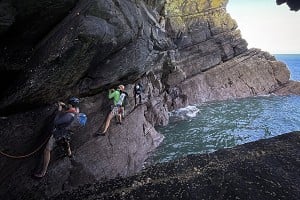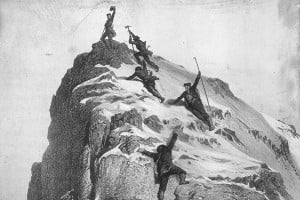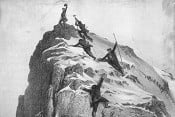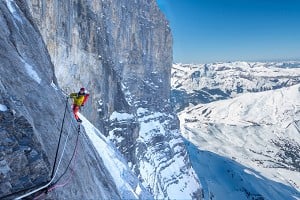
To celebrate the new edition of 'Climbing Days' (1935) by mountaineer and Pinnacle Club founder Dorothy Pilley, Canongate shares an extract in which Dorothy, her husband I. A. Richards and guide Joseph Georges make the coveted first ascent of the north-north-west ridge of the Dent Blanche (4,357m) in the Swiss Alps.
CHAPTER XVI THE GREAT YEAR (1928)
A day came when we stood with the luggage in the car ready to drive down to Victoria, with tickets to Grenoble actually in our pockets. A telegraph-boy arrived with one minute to spare and a message from Joseph suggesting that as the season was so extraordinarily dry we might like to think again about the Dent Blanche! It took us until Victoria to write out our answer, and we were still feeling irrational when we found ourselves strolling with Joseph in the shadow of the Veisivi.
'All things considered,' as Théophile Ribot remarked, 'there is room to wonder whether there is not, in every grande passion, as much misery as joy.' There had been a marked absence of any mention of the Dent Blanche in our plans for some years. In fact we had officially quite given up the idea. In 1925, while I was in Canada, I. A. R. had spent more than half his climbing holiday at Haudères scowling dolefully with Joseph into the clouds which hung low about the Bricolla Alp. They built a stone house on the Col de la Dent Blanche (11,628 ft) in a snow-storm, probably just to show the mountain they were in earnest. When completed it seemed even chillier inside than out. The wind whistled so dismally through the chinks that long before it was finished each had privately renounced any intention of sleeping in it under any circumstances. Down came the sleeping-bags, spare ropes, stove, saucepan and all the other impedimenta again, and so ended that season.
Earlier that year a very strong Swiss party had camped on the Col for two days and declared the ascent hopeless. Later, in 1926, M. Kropf and the Zinal guides, Marcel Savioz and Jean Genoud, had made a descent, mainly by roping down, and had been benighted, in a far from enviable position, in the midst of the difficulties. We all seemed now convinced that enough had been sacrificed to folly. Anyhow, rather painstakingly, no one had mentioned it even obliquely when we came back from our world tour. Yet here we were plodding up through the sweet-smelling meadows, swaying with harebells and marguerites, towards it again!
To get into reasonable training from a distinctly minus condition within a week was our first task. This haste seemed necessary both because the long spell of extraordinarily fine, dry weather might break any day and because a rival party starting from the Mountet might, we feared, be on the mountain before long. There were other parties as to whose intentions we were more than a little suspicious and we were anxious to have at least the first try. So with an impatient eye on our distressingly unfit condition we toiled over the Pointe de Bricolla to the Moiry Hut and bustled over the little pinnacles of the Aiguille de l'Allée. Below the Moiry Hut the alp was carpeted with purple violas and sharp blue gentians so that it was hard to walk for fear of crushing them.
Next morning gave me an entirely new view of crevasses—an inside view, in fact. My first such exploration and, I hope, my last. At that time, with all respect for glacier traps, I would have agreed with Mr Finch, who says, in The Making of a Mountaineer, that 'in summer, except perhaps immediately after heavy falls of fresh snow, it should be possible for a party to avoid this danger altogether'—the danger, namely, of falling into a crevasse. On this occasion there had been no new snow. We were going tranquilly up a gentle, perfectly innocent-seeming slope when it happened. Our feet were sinking about an inch into good snow and I was treading in the impressions of Joseph's feet and enjoying the sparkle of the sunshine in the ice crystals of the surface. There is no way of describing the suddenness with which—as though some hidden hangman had pulled his lever—I dropped into darkness. I felt as though I were falling for hundreds of feet. Then the jerk came. A smothering cascade of ice and snow fragments was pouring over me and I was dangling helplessly in a noose on a rope that made me feel like a bar of cheese that is being divided. Luckily the walls of my crevasse, where I hung, bulged towards one another hour-glass fashion. With violent wriggles I was just able to touch one wall with my toes while working my shoulder against the other. Below me widened out a horrible blue-black gulf as vast as the inside of St Paul's, into whose invisible depths the fragments of the bridge which had collapsed with me vanished with a thudding uproar. Above me, the edges of the broken roof caught the sunshine. My rope—forward to Joseph, backwards to I. A. R.—had cut deeply through the eaves on each side.
Getting me out struck me as a long job, though they said it was not. We shall never agree on the time it took. Pity the poor judge who has such witnesses to listen to. Joseph had to make a detour round the crevasse while I. A. R. held me. Then with a joint effort they hauled me up. I was glad to see them and the daylight again. We looked hard but could see no sign of the crevasse except the gaping mouth of my pit. I walked for the rest of the day as though on a soap film.
From the summit of the Grand Cornier our Dent Blanche ridge looked at its best—gigantic, formidable and tantalizing in its still-concealed mysteries. What would happen at the overhang, we kept on wondering? It was quite evident where the main problem would be. We went down the Grand Cornier's East Ridge, a baking descent, and crossed to the Col de la Dent Blanche. The opposing faces of the Grand Cornier and the Dent Blanche—stripped of their snows, dry as they are in few years—were chanting and roaring to one another with falling débris. As we trudged wearily up the snows towards the Col a peculiar formation of slabs on the Cornier discharged a heavy stonefall by ricochet an incredibly long way across the glacier. The newly bared rock-faces seemed nearly every¬where ready to slip away and bombard the slopes below. We resolved again to give up the climb if we could not keep strictly to the ridge.
We took two days' complete rest at Bricolla. Antoine, Joseph's brother, joined us, for we had decided to climb on two ropes for speed, linking up for the glacier and the difficult sections. Two on a rope go faster than three or four, as anyone who thinks of a loop caterpillar will understand. Antoine had missed his military service through a temporary physical defect and so cannot ever have his guide's certificate. But he is as sound a man on a mountain as could be wished, with an enchanting sense of humour and a serene belief in his brother's genius. His tranquil cheerfulness through the more exciting passages of the climb was an immense support to the party. Our first evening at Bricolla was enlivened by the appearance of a caravan which for no reason at all we took for our rivals. The second day needed some enlivenment. Our nerves were taut as before the start of a great race or an examination. We lay in bed as long as we could, we went out and lay on the grass, we lay in the shade, in the sun. But wherever we were, a peculiar restlessness seemed to assail us. Theoretically we were sleeping, or at least resting. Actually we were fretting ourselves sick. We could almost catch one another's glances sweeping round magnetically to that overhanging corner of the ridge. Antoine voiced the trouble perfectly as he glanced smilingly round our three serious faces: 'Ah, demain soir on chantera!' We burst into laughter at being so easily caught.
We got away at one o'clock by lantern-light on July 20th, with every reason to expect a perfect day. Joseph, usually gently sociable in the early hours, this morning seemed aloof and austere. We had seen something like it before when setting out for unusual expedi¬tions. The aloofness marks the concentration of his powers; he gains a mental poise as remarkable as his physical balance. Unlike many brilliant performers, he is never impulsive when at grips with the difficulties. His excitement takes the form of a severe self-control.
Dawn found us on the Col de la Dent Blanche, a rocky rib between two systems of glaciers. It was a freezingly cold, clear morning, and the Zermatt giants—Weisshorn, Rothorn, Gabelhorn—stood up in stark majesty between us and the growing light. We had breakfast (5.45 to 6.15 a.m.) and then split into two ropes. A two-hour scramble over miscellaneous rocks went quickly. Looking back now it seems to have passed like two minutes. Then came the only passage of poor rock on the climb, loose, fissile stuff which breaks away if handled unwarily. It was soon passed and we came to the great slabs.
These slabs trend at a very high angle over to the west, solid bare rocks steeper than a house-roof, sprinkled with grit and spattered even in a dry season with a thin, transparent, treacherous film of verglas. Anchorage is lacking, and their lower edge, which we skirted, overhangs. As we crept along it, the pebbles we swept aside to get clearer footing for our rubber shoes would hop a few feet and then vanish. Up from the depths would come a faint wail as they sang through thousands of feet of air. Larger pieces screamed savagely. The void below was hidden, but these eerie sounds reminded us of it. We turned upwards near the western limit of this eave and found two awkward and holdless chimneys to take us to a broken ledge which winds along immediately beneath the fearsome impending crags of the North Ridge.
There the flank of the upper half of the ridge literally overhangs the slabs. It is cut by a number of clefts which from below may have tempted the imaginations of many climbers. At closer quarters, their gigantic scale and fierce angle are more apparent. A detached pinnacle clinging to the edge of the slabs at this point was tipped with sunlight. It forms the notch which shows up so well both from the Bertol and the Mountet. All the rest of this face of the mountain was still in deep, cold shadow. We scrambled out to the pinnacle to survey the terrain, for now our projects and hopes were to be put to the test. And desperate their chances seemed.
Anything less encouraging than the arête as seen from this point would be hard to imagine. To begin with, the actual blade of the narrow ridge above overhangs perceptibly at several points. To the left a deep crack in its side seems to offer better chances of ascent, only to end in a much worse overhang some 100 feet higher. Above this, there flapped in the cold wind evidence of the Swiss party's descent, a frayed loop of the rope they had left behind them, flung back by the gales and hitched up among the crags. On the right is the smooth, exceedingly steep wall of the vast couloir furrowing the cliff down to the Glacier de la Dent Blanche. At one time we had talked of crossing this couloir and returning, at a higher level, to the ridge. But one glance into its bruised and stone-swept depths was now enough. There was, however, something like a remotely possible crack in its smooth wall, a crack which passed at its critical point out of sight into the unknown.
In the searching breeze we clung to the bitterly cold rocks of the pinnacle, and gazed at these crags black against the now sun-filled blaze of the sky. We were just inside their shadow, a golden touch or two showed where the angle of the ridge above eased off. Our difficulties would be over when we reached that warm and welcoming glow 150 feet above us, but for the moment they seemed overwhelming. Whatever estimate subsequent parties may make of this passage, there is no doubt that as a daunting spectacle it will always hold high rank.
Joseph now began a series of explorations which seemed to us to touch the limiting mark of cragsmanship. He started by exploring the wall of the great couloir round the corner to the right—an anxious moment for us, since he was soon out of sight and we could easily tell by the inch by inch movement of the rope that the ground was exceedingly severe. We could do little to safeguard him as he slowly gained height. But Antoine's calm reflective confidence in his brother's skill, his quiet assumption that everything was normal, was a great reinforcement to our trust in Joseph's judgment. In such situations the amateur has a responsibility which can easily become agonizing. It was with a mixture of disappointment and relief that we began to take the rope in again, 90 feet of it, and soon we were welcoming Joseph among us once more. He had been within a few feet of success but those few feet had proved insuperable.

After a pause for chilled hands to regain their strength, the second possibility was reconnoitred. This was the crack on the left, which proved both extremely hard to get into and unluckily impossible to get out of at the top. With the greatest difficulty Joseph contrived to force nearly 100 feet of the crack. Then the problem of escaping from the overhangs which close this route came to a head. At one moment he seemed almost to be emulating a lizard on a ceiling. But human beings lack the necessary organs apparently, and we were forced to watch a series of descending movements extraordinarily reassuring in their witness to his climbing reserves. When he rejoined us on our belvedere, he told us that he had been within a few feet only of a series of holds that would have taken him up.
There remained the very nose of the ridge itself. It seemed a hopeless chance. A few sinuous, very shallow grooves wound up among its protuberant bosses, but they were mercilessly smooth and no square-cut hold showed as far as the eye could reach. There could be no rest or anchorage for the leader for at least 100 feet. And, to begin with, the base of the nose was undercut. Its very beginning seemed inaccessible. Once on the tip the leader would be on the steepest possible rock with a clear 3000-odd feet of space under the palms of his feet. Frankly it was almost with dismay that we saw Joseph, after a thoughtful survey, turn to it.
The first step was to mount the initial overhang. There happened to be a cleft in the rock under the eave into which an axe-shaft could be fixed, leaving the rest protruding like a spring-board over nothing. We made sure that it was fixed, but to gain its vibrating head without assisting holds was no easy matter. From this vantage point the overhang could be breasted. The next stretch turned, it seemed to us later, upon one rather rounded hold. Hand, knee and then foot it served, while the fingers found only pressure thrusts to direct the balance. Breathlessly we watched Joseph's smooth, seemingly effortless movements. He kept up a flow of patois remarks to Antoine as he worked across and upwards. Soon he was only a shapeless silhouette against the dazzle of the sky above. It seemed impossible that he should be able to stay at all in as steep and smooth a passage, much less that he should be able to continue. After a while, as the rope still ran out, his voice grew dim with distance and we lost sight of him in the glare. Suddenly came a sharp exclamation: it sounded like 'Je chouques!' Antoine, calm as ever, translated, 'Il est là.' The tension was over; or, rather, changed its direction altogether. Now it was our turn!
Most of the passage had to be done by the oddest series of counterpoised pressures I have ever had to manage. All on a surface too steep to allow any of the usual margin of balance. An occasional pinch-hold was a luxury. The friction of a rubber sole or the palm of the hand on some small awkwardly sloping surface had to be enough. It was with a very queer sense of unreality—as though a dream had got out of place—that I came at last to a rapturous Joseph perched on little or nothing and tied to the cliff with a network of rope by which he had supplied me with a spare handline.
The landing-place, on which I joined I. A. R., was a nook the size of a dinner-plate, with one handhold! It needs some experience for two people to stow themselves in such a place with comfort. The contortions of the human body are, fortunately, easier to perform than to describe. For a time we were busy with the problem of how to stay there together and keep the sacks, which had been hauled up on an independent rope, from departing. There was no room to put them on again as yet. But there is an old climbing maxim about halting-places, 'Where there is room for one there is room for two', which applies to cliff-faces though not to chimneys. The second man can at least stand on the first man's foot!
Joseph meanwhile was occupied with Antoine, to whom fell the job of bringing up the last axe and thus doing without it as a springboard for the overhang. Since he elected to climb the pitch in boots it has always been a mystery to me how he did it. The overhang involved him in a voluntary leap into the void. We believed him when he said it gave him 'Une drôle de sensation'. But in time he came up the last bulge as placidly as ever, with a broad smile and an 'Ah, les amoureux!' as he spied us clinging together to our joint and solitary hold. After this, what remained of the wall was only steep, its holds seemed superb in comparison with the passage below. Joseph disappeared again, there was another pause while the sacks and axes went up; and then, suddenly, we topped a wall of rough yellow rock to a ledge and the sunshine.

We lay and basked and ate and relaxed. The ridge above promised nothing more than is normal to a great Alpine ridge. Its rough, golden rocks stood up in bold, very practicable masses, enchanting to our eye by contrast to the shadowy, frowning walls below. The plaster of ice and snow patches that decorated them would this year give no trouble. Time now was our only opponent. It was 1.30 and we had a long way still to go, so for comfort and speed we roped in twos again. From time to time, down in the recesses of the mountain below us on the right, rocks would be thawed out by the sun, slip away, slide down a snow-patch, hop, whir and vanish into the great couloir, but we were in complete safety as we clambered on our ridge. Under the clear sky the Alps basked in a heat-haze. Less than a pin's head in size, the Bricolla Chalet, our starting-point, shone among its meadows.
Triumph gave us wings, and the rocks were really exhilarating, like the most sporting parts of the usual South Ridge of the mountain. Still, they were long, the day was far advanced (we had taken three hours and twenty minutes over the crucial two hundred feet) and it was five o'clock before we reached the summit. We did not pause for long, nor did we linger on the descent. In fact we raced down the southward rocks, for the sun sank with that peculiar suddenness it shows when you are sinking also. The valleys were filling with gloom as we turned down over the damp snows of the glacier. We were in no further hurry. We had only to walk, at leisure, home to bed. Only then did fatigue descend upon me—like a black bonnet, so that I stumbled on the granulated re-frozen ice of the dry glacier, and among the tangled moraines through which the track winds its way down to Bricolla. But a current of sleepy beatitude flowed through one's veins. Not even my right foot seemed heavy, on which by accident I had been wearing one of I. A. R.'s spare boots throughout the day! A spell had been exorcized, a dream replaced by a reality which transcended it. In all the literal force of the word we were content. Once again, as I turned into bed, the candle went unextinguished and guttered itself out unheeded, so suddenly did blissful sleep descend.
















Comments